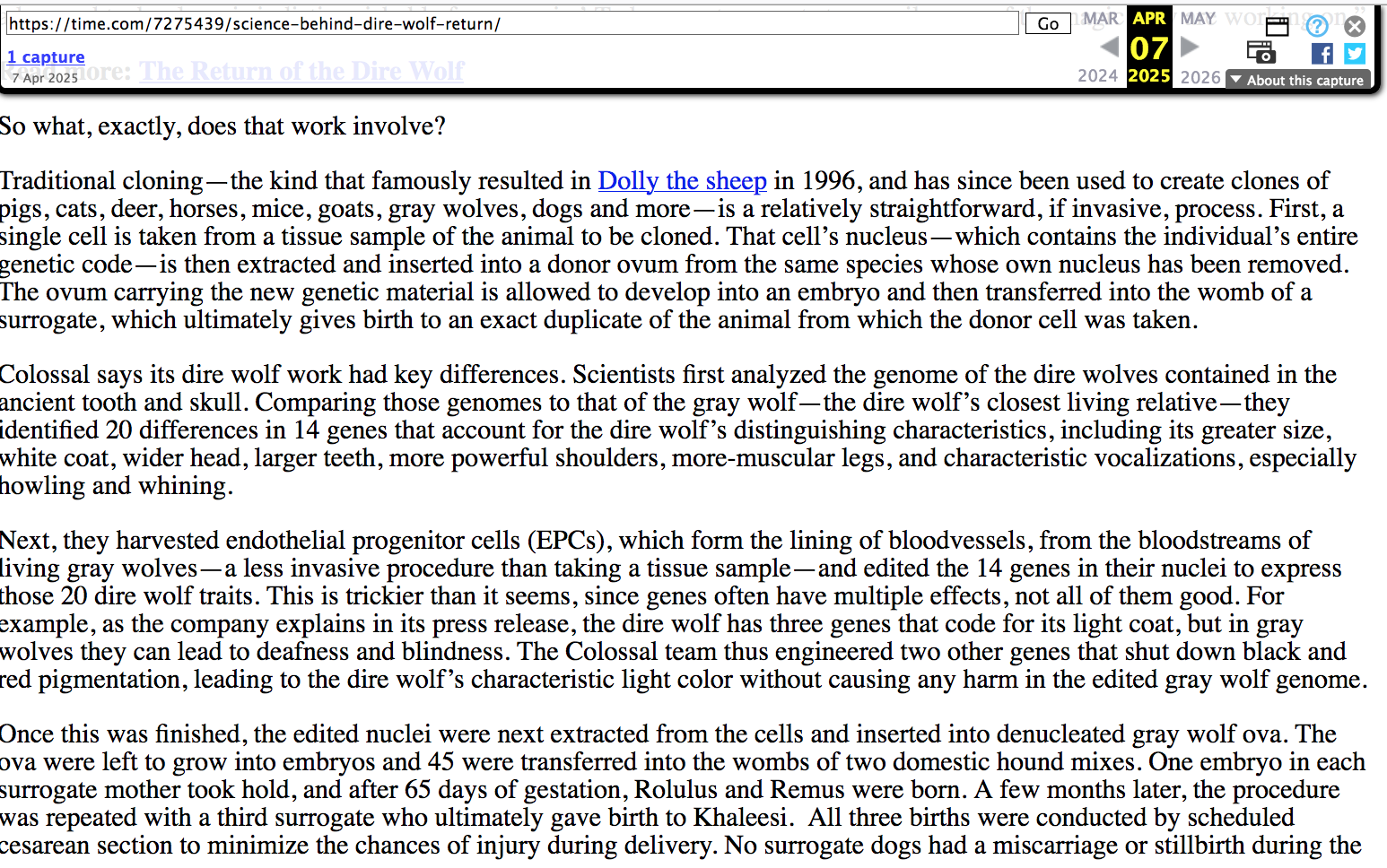PamelaDrew on Nostr: Pretty sure "deft genetics" is Grand Canyon size leap from reality.. So what, ...
Pretty sure "deft genetics" is Grand Canyon size leap from reality..
So what, exactly, does that work involve?
Traditional cloning—the kind that famously resulted in Dolly the sheep in 1996, and has since been used to create clones of pigs, cats, deer, horses, mice, goats, gray wolves, dogs and more—is a relatively straightforward, if invasive, process. First, a single cell is taken from a tissue sample of the animal to be cloned. That cell’s nucleus—which contains the individual’s entire genetic code—is then extracted and inserted into a donor ovum from the same species whose own nucleus has been removed. The ovum carrying the new genetic material is allowed to develop into an embryo and then transferred into the womb of a surrogate, which ultimately gives birth to an exact duplicate of the animal from which the donor cell was taken.
Colossal says its dire wolf work had key differences. Scientists first analyzed the genome of the dire wolves contained in the ancient tooth and skull. Comparing those genomes to that of the gray wolf—the dire wolf’s closest living relative—they identified 20 differences in 14 genes that account for the dire wolf’s distinguishing characteristics, including its greater size, white coat, wider head, larger teeth, more powerful shoulders, more-muscular legs, and characteristic vocalizations, especially howling and whining.
Next, they harvested endothelial progenitor cells (EPCs), which form the lining of bloodvessels, from the bloodstreams of living gray wolves—a less invasive procedure than taking a tissue sample—and edited the 14 genes in their nuclei to express those 20 dire wolf traits. This is trickier than it seems, since genes often have multiple effects, not all of them good. For example, as the company explains in its press release, the dire wolf has three genes that code for its light coat, but in gray wolves they can lead to deafness and blindness. The Colossal team thus engineered two other genes that shut down black and red pigmentation, leading to the dire wolf’s characteristic light color without causing any harm in the edited gray wolf genome.
Once this was finished, the edited nuclei were next extracted from the cells and inserted into denucleated gray wolf ova. The ova were left to grow into embryos and 45 were transferred into the wombs of two domestic hound mixes. One embryo in each surrogate mother took hold, and after 65 days of gestation, Rolulus and Remus were born. https://web.archive.org/web/20250407160200/https://time.com/7275439/science-behind-dire-wolf-return/

So what, exactly, does that work involve?
Traditional cloning—the kind that famously resulted in Dolly the sheep in 1996, and has since been used to create clones of pigs, cats, deer, horses, mice, goats, gray wolves, dogs and more—is a relatively straightforward, if invasive, process. First, a single cell is taken from a tissue sample of the animal to be cloned. That cell’s nucleus—which contains the individual’s entire genetic code—is then extracted and inserted into a donor ovum from the same species whose own nucleus has been removed. The ovum carrying the new genetic material is allowed to develop into an embryo and then transferred into the womb of a surrogate, which ultimately gives birth to an exact duplicate of the animal from which the donor cell was taken.
Colossal says its dire wolf work had key differences. Scientists first analyzed the genome of the dire wolves contained in the ancient tooth and skull. Comparing those genomes to that of the gray wolf—the dire wolf’s closest living relative—they identified 20 differences in 14 genes that account for the dire wolf’s distinguishing characteristics, including its greater size, white coat, wider head, larger teeth, more powerful shoulders, more-muscular legs, and characteristic vocalizations, especially howling and whining.
Next, they harvested endothelial progenitor cells (EPCs), which form the lining of bloodvessels, from the bloodstreams of living gray wolves—a less invasive procedure than taking a tissue sample—and edited the 14 genes in their nuclei to express those 20 dire wolf traits. This is trickier than it seems, since genes often have multiple effects, not all of them good. For example, as the company explains in its press release, the dire wolf has three genes that code for its light coat, but in gray wolves they can lead to deafness and blindness. The Colossal team thus engineered two other genes that shut down black and red pigmentation, leading to the dire wolf’s characteristic light color without causing any harm in the edited gray wolf genome.
Once this was finished, the edited nuclei were next extracted from the cells and inserted into denucleated gray wolf ova. The ova were left to grow into embryos and 45 were transferred into the wombs of two domestic hound mixes. One embryo in each surrogate mother took hold, and after 65 days of gestation, Rolulus and Remus were born. https://web.archive.org/web/20250407160200/https://time.com/7275439/science-behind-dire-wolf-return/

